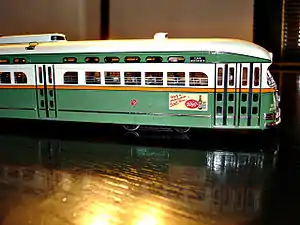1950 Chicago streetcar crash
The 1950 CTA Streetcar Crash, also known as the Green Hornet Streetcar Disaster, occurred on May 25, 1950, when a Chicago Transit Authority streetcar collided with a gasoline truck.[1] The resulting explosion killed 34 people and injured 50 others, remaining one of the most deadly public transit disasters in Chicago history.[2]
 A model replica of the Green Hornet streetcar | |
| Details | |
|---|---|
| Date | May 25, 1950 |
| Location | Chicago, Illinois |
| Country | United States |
| Line | Green Hornet Streetcar |
| Incident type | Collision |
| Cause | Driver error |
| Statistics | |
| Deaths | 34 |
| Injured | 50 |
| Damage | $150,000 (estimated to be $1,502,663.90 in 2016) |
Crash
The collision occurred around 6:30pm on May 25, 1950.[3] The accident happened at the intersection of 63rd and State Street, killing and injuring people in the two vehicles and the surrounding area.
The streetcar was headed south on State Street but suddenly switched eastbound to avoid a flooded underpass.[1] “Apparently, the motorman of the streetcar was not paying attention, and went through that switch at total velocity, and hit the side of that truck with dire consequences,” said Craig Cleve, author of the book The Green Hornet Streetcar Disaster.[1] The gasoline truck jackknifed after the collision and blocked State Street 200 feet north of 63rd Street.[3] The driver of the truck, Mel Wilson, died in the cab of the truck while the conductor of the streetcar, William C. Lidell, survived.[3]

The location of the crash was on the South Side of Chicago
Consequences
34 people died in the streetcar while 50 people, some on the streetcar and others in the surrounding area, were injured.[1][4] According to the National Safety Council’s report two days after the crash, it was the largest death toll from a motor vehicle collision, surpassing the 29 people killed in a 1940 Texas train-truck collision.[5] Some victims were identified immediately because of personal belongings whereas other victims were identified at the Cook County Morgue by friends and relatives in the days following the crash.[6]
In addition to the lives lost, nearby buildings and parked cars were consumed by the flames.[3] Five buildings were completely destroyed on the east side of State Street between the 6239 and 6247 addresses.[3][5] The total property damage was estimated to be around $150,000 (estimated to be $1,502,663.90 in 2016).[5][7] William C. Liddell, the streetcar conductor, disappeared after the crash but was arrested the day after, charged with leaving the scene of the accident.[5]
Aftermath
In 1955, the Chicago Transit Authority claimed it paid a total of $900,000 to families of the deceased.[4] The accident was highly investigated, drawing conclusions as to what could prevent another such catastrophe. Among them were the addition of drainage systems for frequently flooded underpasses so operators would not have to detour, two yearly physical examinations of motormen and streetcar doors that could remain open in case of an emergency to allow for evacuation.[4] However, in 1958 the CTA elected to stop using streetcars entirely. They were replaced by bus routes that still run today.[1]
References
- "On This Day in 1950: The Green Hornet Streetcar Disaster". CBS Chicago. May 25, 2012. Retrieved October 15, 2016.
- "Car Accidents in Chicago | Will Vision Zero Produce Results?". Injury Attorney Chicago. 2017-06-27. Retrieved 2019-10-04.
- "Victims Trapped in Blazing Wreck; Bodies Burned Beyond Recognition". Chicago Daily Tribune. May 26, 1950. Retrieved October 19, 2016.
- "Flaming Death In the Green Hornet Crash Of May, 1950". Chicago Tribune. June 9, 1985. Retrieved October 19, 2016.
- "6 Inquiries Begun in Crash Disaster". The New York Times. May 27, 1950. Retrieved October 19, 2016.
- "33 Burn to Death in Chicago As Street Car Hits 'Gas' Truck". The New York Times. May 26, 1950. Retrieved October 19, 2016.
- "CPI Inflation Calculator". United States Department of Labor.